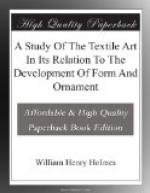* * * * *
I have dwelt at sufficient length upon the character and the tendencies of the peculiar system of embellishment that arises within textile art as the necessary outgrowth of technique, and now proceed to explain the relations of this system to associated art.
In the strong forward tendency of the textile system of decoration it has made two conquests of especial importance. In the first place it has subdued and assimilated all those elements of ornament that have happened to enter its realm from without, and in the second place it has imposed its habits and customs upon the decorative systems of all arts with which the textile art has come in contact.
GEOMETRICITY IMPOSED UPON ADOPTED ELEMENTS OF DESIGN.
At a very early stage of culture most peoples manifest decided artistic tendencies, which are revealed in attempts to depict various devices, life forms, and fancies upon the skin and upon the surfaces of utensils, garments, and other articles and objects. The figures are very often decorative in effect and may be of a trivial nature, but very generally such art is serious and pertains to events or superstitions. The devices employed may be purely conventional or geometric, containing no graphic element whatever; but life forms afford the most natural and satisfactory means of recording, conveying, and symbolizing ideas, and hence preponderate largely. Such forms, on account of their intimate relations with the philosophy of the people, are freely embodied in every art suitable to their employment. As already seen, the peculiar character of textile construction places great difficulties in the way of introducing unsymmetric and complex figures like those of natural objects into fabrics. The idea of so employing them may originally have been suggested by the application of designs in color to the woven surfaces or by resemblances between the simpler conventional life form derivatives and the geometric figures indigenous to the art.
At any rate, the idea of introducing life forms into the texture was suggested, and in the course of time a great deal of skill was shown in their delineation, the bolder workmen venturing to employ a wide range of graphic subjects.




